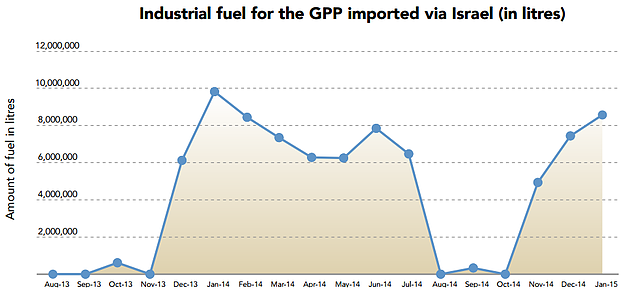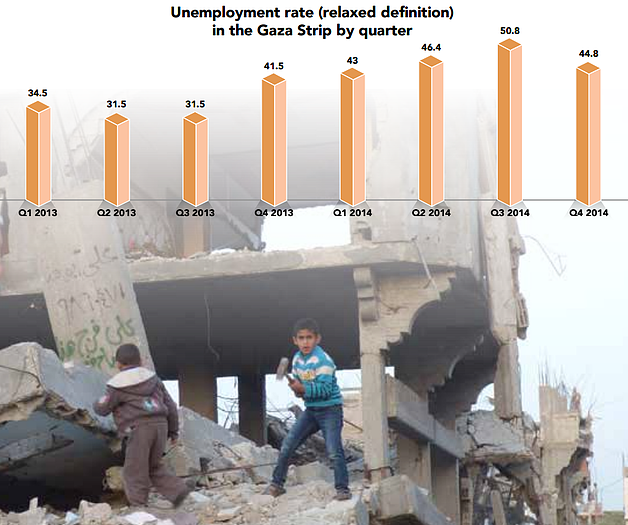Concern over further deterioration in food security and quality of services in the Gaza Strip
Key drivers include nonpayment of salaries and the energy crisis
The fragile humanitarian situation prevailing in the Gaza Strip following the summer 2014 hostilities and the longstanding blockade, deteriorated further during the month.
A key driver of deterioration is the ongoing nonpayment of salaries to public sector employees, which is now affecting those on the Palestinian Authority’s (PA) payroll as well. The salary crisis is undermining the resilience and food security of the population and the quality of basic services provided to them. The delivery of basic services is also hampered by the lack of an approved budget allowing regular operations by Gaza-based ministry offices, alongside the longstanding energy crisis.
Unresolved salary crisis
At least 40,000 civil servants and security personnel recruited by the de facto Hamas authorities have not received full salaries since November 2013, or any salary since April 2014, apart from a one-off humanitarian payment of $1,200 (excluding members of the security forces). The payment of these salaries is contingent on an agreement on the integration of these employees into the civil servant workforce established under the GNC. The lack of progress on this issue appears to obstruct the resolution of other issues related to the GNC, such as the administration of the Palestinian side of the Gaza crossings.
Another 70,000 civil servants on the PA payroll, most of whom have not been working since the Hamas takeover in 2007, received only 60 per cent of their December 2014 salaries, while the payment of January 2015 salaries is currently unclear. This situation was triggered by Israel’s decision to withhold the transfer of $127 million of tax revenues collected in December 2014 on behalf of the PA as a punitive measure in response to Palestine’s accession to the International Criminal Court in January 2015. The decision was recently extended to January’s transfers.
The contrast in policy towards the two groups of civil servants over the past year has been a continuous source of internal tension in Gaza. In one incident in January 2015, hundreds of civil servants blocked the entrance to the GNC’s headquarters during a visit to Gaza by West Bank-based ministers and demanded that their salaries be paid.
Energy crisis
Despite a slight increase in the amount of fuel delivered to the Gaza Power Plant (GPP) in January 2015 and the temporary operation of a third turbine, the plant continues to run on half capacity due to fuel shortages. This impacts the delivery of basic services. The main factors behind the fuel shortages include major funding gaps, lack of long-term agreement on the exemption of fuel from taxes by the Palestinian Ministry of Finance in Ramallah, and insufficient storage capacity after the fuel tanks were hit by an Israeli air strike on 29 July 2014. The GPP needs to receive up to 500,000 liters of fuel per day without interruption to run at full capacity and produce 120 megawatt (MWs).
Gaza currently receives about 210 MWs, or less than half of the estimated demand (around 450 MWs), including 60 MWs from the GPP, 120 MWs from Israel and 30 MWs from Egypt. The pressure on public services continues to mount as many critical installations face power cuts of up to18 hours per day, while lacking the fuel needed to run back-up generators. The purchase of fuel by a limited number of essential health, WASH and municipal installations is currently being secured by international donors, who fund 600,000 liters a month, or about 60 per cent of the estimated needs.

Health
The health sector has been plagued by workers’ strikes triggered by the non-payment of salaries since May 2014. Staff attendance has also fallen and absenteeism is reported at approximately 50 per cent, partially attributed to the inability of health staff to afford transportation costs. It is estimated that unless a solution is reached in the near future, all medical personnel employed by the Hamas de facto authorities, accounting for some 46 per cent of the workforce, will strike and major disruption will occur in health services.
In December 2014, some 750 cleaning personnel contracted by the Ministry of Health (MoH) in Gaza went on a 16-day strike protesting the nonpayment of their salaries for six months. This resulted in the suspension of all cleaning services to 13 hospitals and 56 primary health centres, forcing the MoH to suspend a range of medical services, including all services in out-patient clinics at hospitals, obstetric and gynecology services, and nonurgent surgeries. The risk of contamination and spread of diseases in medical facilities is significantly heightened. The issue remains unresolved and cleaning workers continue to threaten to strike.
This is an additional blow to Gaza’s health system, already battling chronic energy problems and shortages of equipment and medical supplies. The lack of a reliable electricity supply has resulted in disruptions to some health services, including a halt to all non-urgent elective surgeries, and also to ambulance transportation, sterilization, and catering and laundry services.
* Information in this section was provided by the World Health Organization (WHO) and the Ministry of Health
Water and sanitation
In this dire economic situation, the lack of salary payments and the diversion of meager resources by families to home repairs and reconstruction, have resulted in water utility payments falling from 48 per cent just prior to the July-August hostilities, to 30 per cent in January 2015. Water providers have been forced to reduce operations and network maintenance due to the shortage of funds to purchase fuel for back-up generators. At present, only 40 per cent of water and sanitation installations are operational, some of them relying mainly on fuel provided via emergency fuel assistance. As a result, some 270,000 people receive no water supply at all and are dependent on water tankers. Since the July-August hostilities, the average daily water supply has dropped from 80 to 45-50 litres per capita per day across Gaza, less than half the international recommendation. For municipal services, fuel shortages and the lack of equipment have resulted in the frequency of solid waste collections being reduced from up to four times to two to three times per week since July 2014.
* Information provided by WASH cluster and service providers.
Palestinian Civil Defence
Due to a lack of resources, including fuel and salary payments, the Palestinian Civil Defence (PCD) in Gaza has reduced its operating capacity; workforce attendance is at approximately 40 per cent and vehicle movement has reduced to 30 per cent. The PCD noted that the lack of resources has been more acute than the nonpayment of salaries. All services for which alternatives to the PCD exist in Gaza, such as ambulance services, have been scaled back or stopped and priority given to maintaining the fire fighting service, for which no alternative exists. Equipment shortages and a lack of training opportunities further hamper the emergency preparedness and response capacity of the PCD as one of the first responders to an emergency in Gaza (see also article on winter storm).
Unemployment and food insecurity
This month the International Monetary Fund (IMF) disclosed that real GDP in Gaza declined by about 15 per cent during 2014, primarily due to the July-August hostilities, while for the oPt as a whole it fell by nearly one per cent, the first contraction since 2006.[1]

Stimulated by the limited reactivation of the construction sector in the context of the Gaza Reconstruction Mechanism, the unemployment rate recorded in the Gaza Strip in the fourth quarter of 2014 fell compared to previous quarters.[2] However, the current rate of 44.8 per cent of the workforce (relaxed definition)[3] is one of the highest in the world, and more than 13 percentage points above the equivalent figure in mid-2013. Since that date, the economic situation in the Gaza Strip deteriorated rapidly following the closure of smuggling tunnels with Egypt, which were the main mechanism for the supply of building materials. Combined with the impact of the Israeli blockade on the Gaza economy, this led to a near collapse of the construction sector.
The ongoing salary crisis has prompted some humanitarian agencies operating in the food security sector to advance their food distribution cycle. Currently over one million people across the Gaza Strip receive food assistance, mainly from UNRWA and WFP. Beneficiaries are regularly re-assessed and new applicants are considered for support on a regular basis. In recent months, families affected by the salary crisis have become unable to cover their basic needs and have been progressively included in the food assistance caseload.
[1] Statement at the End of an IMF Mission to the West Bank and Gaza. Press Release. January 2015.
[2] Palestinian Central Bureau of Statistics, Labour Force Survey.
[3] The relaxed definition includes ‘discouraged workers’ who wished to work, but did not actively seek a job during the week of the survey due to the perceived lack of opportunities.









